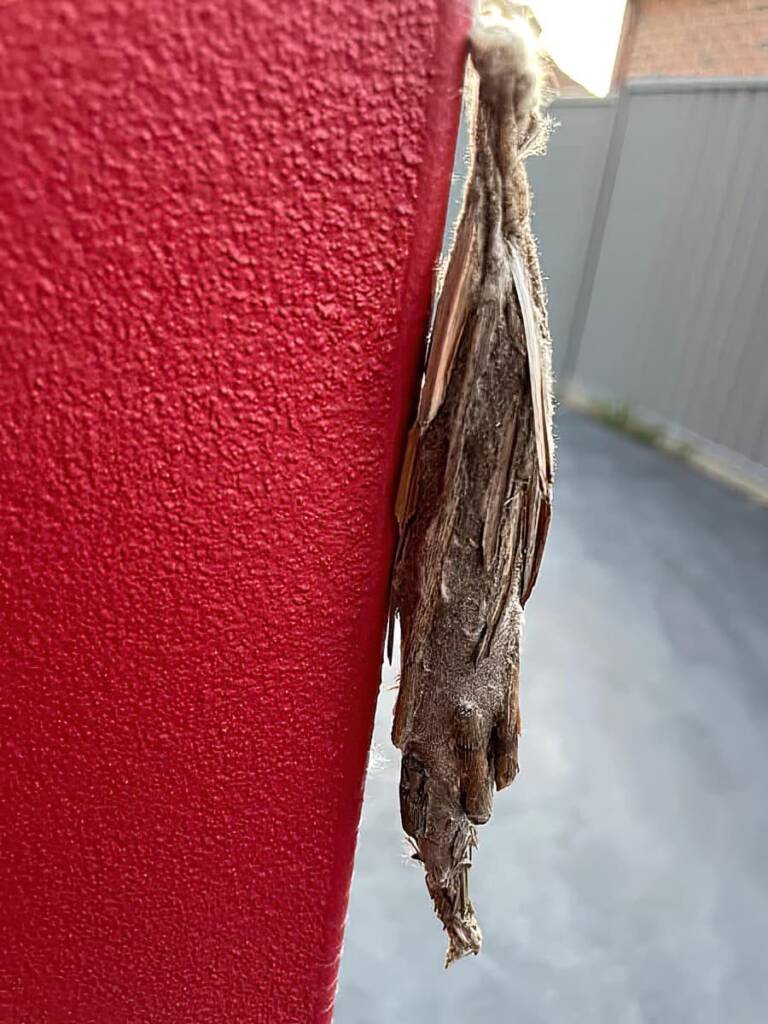Saunders’ Case Moth (Metura elongatus)Metura elongatus Male
The Saunders’ Case Moth (Metura elongatus), also known as the Large Bagworm, belongs to the Psychidae family.
The caterpillar of the Saunders’ Case Moth live and pupate in a silken casing. The early instar of the Saunders’ Case Moth initially cover their casing with bits of leaf. As they grow in their case, they attach parallel short twigs over the surface of the case. The amount of twigs attached to the casing most likely be affected by what is available in their immediate surrounding. The following photos appear to show the Saunders’ Case Moth with a fur-silk collar. As well as short twigs, some of the attachments to the outside of the case are paper-thin plant material.

The caterpillar live and pupate within this silken bag case, providing it shelter and safety. When threatened, they temporarily seal the front opening of the case until the danger is past.

In the natural environment the Saunders’ Case Moth are found attached to the plants they feed on. They are also often seen attached to walls and fences in urban settings.

The case / bag of the Saunders’ Case Moth and many other species of case moths have two openings. There is the larger ‘mouth’ through which the caterpillar protrudes its head and thorax to feed and move, and a smaller hole at the other end of their shelter through which the droppings are ejected.

Check out our Insects > Moths and some of the other different types of Case Moths, including our Ribbed Case Moth.
- Scientific classification
- Kingdom: Animalia
- Phylum: Arthropoda
- Subphylum: Hexapoda
- Class: Insecta
- Informal: Pterygotes
- Order: Lepidoptera
- Family: Psychidae
- Subfamily: Oiketicinae
- Genus: Metura
- Species: Metura elongatus

Footnote & References
- Saunders’ Case Moth (Metura elongatus), Images © Murad Abaza
- Australia – What Bug Is This? Facebook group, https://www.facebook.com/groups/Auswhatbugisthis
- Metura elongatus (Saunders, 1847), Atlas of Living Australia, https://bie.ala.org.au/species/urn:lsid:biodiversity.org.au:afd.taxon:07c53617-7d4b-4256-9c96-f6f84d64afcd
- Metura elongatus (Saunders, 1847), Saunders’ Case Moth, Coffs Harbour Butterfly House, http://lepidoptera.butterflyhouse.com.au/psyc/elongatus.html
- Saunders’ case moth, Metura elongatus, Australian Museum, https://australian.museum/learn/animals/insects/case-moths/
- Metura elongatus, Wikipedia, https://en.wikipedia.org/wiki/Metura_elongatus
Saunders’ Case Moth (Metura elongatus)Metura elongatus Male
MothsAedia arctipennis Anthela guenei (Four-Spot Anthelid Moth) Australian Striped Hawk Moth Bag-shelter Moth (Ochrogaster lunifer) Case Moths (Variety of Cocoons) Coenotes eremophilae Convolvulus Hawk Moth Day Flying Moth Emperor Gum Moth (Opodiphthera eucalypti) Four-spotted Cup Moth Green-blotched Moth (Cosmodes elegans) Leaf Case Moth Mistletoe Emperor Moth Plume Moth Rattlepod Moth (Utetheisa) Ribbed Case Moth Sameodes cancellalis Saunders’ Case Moth (Metura elongatus) White-spotted Owl-Moth
